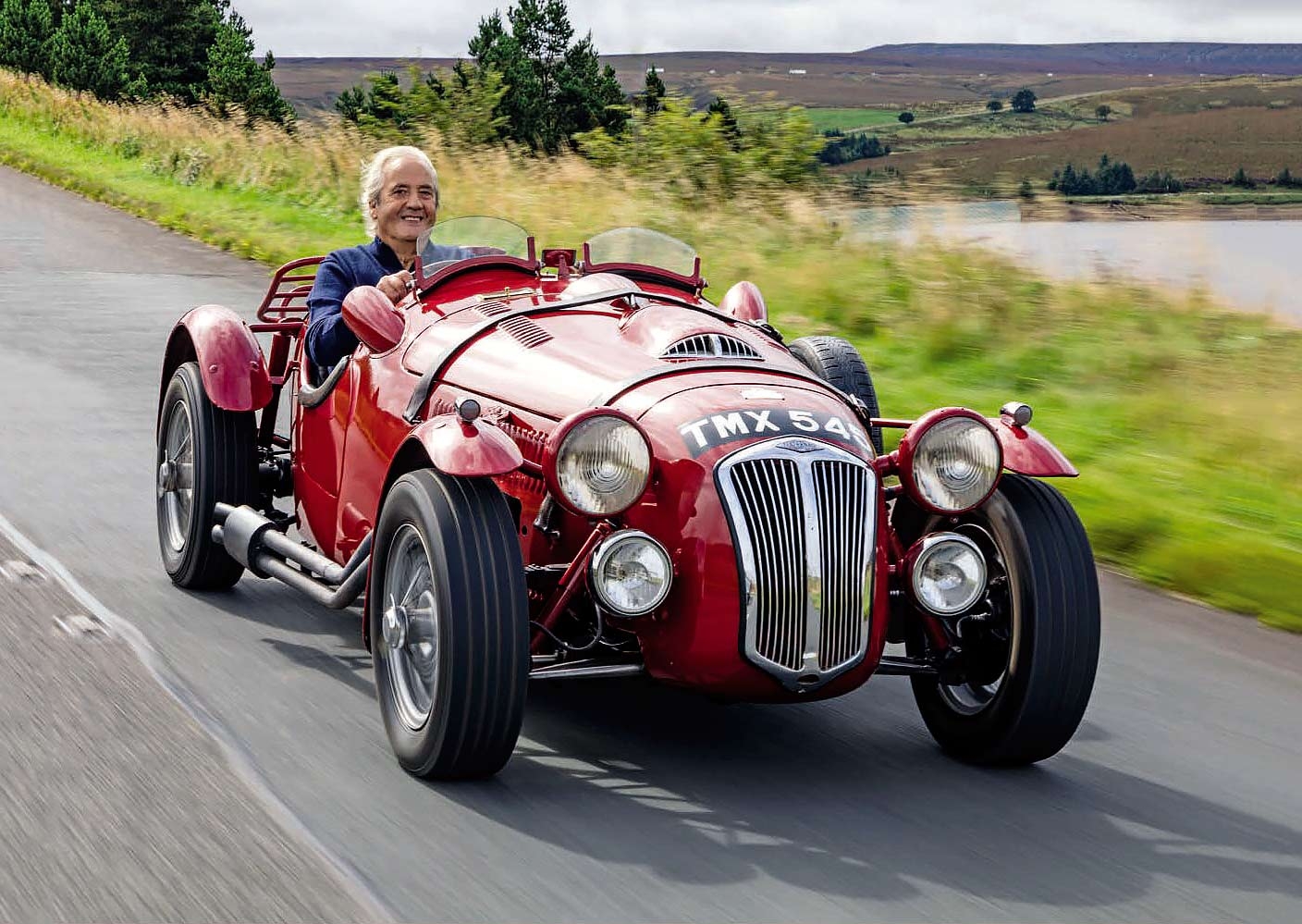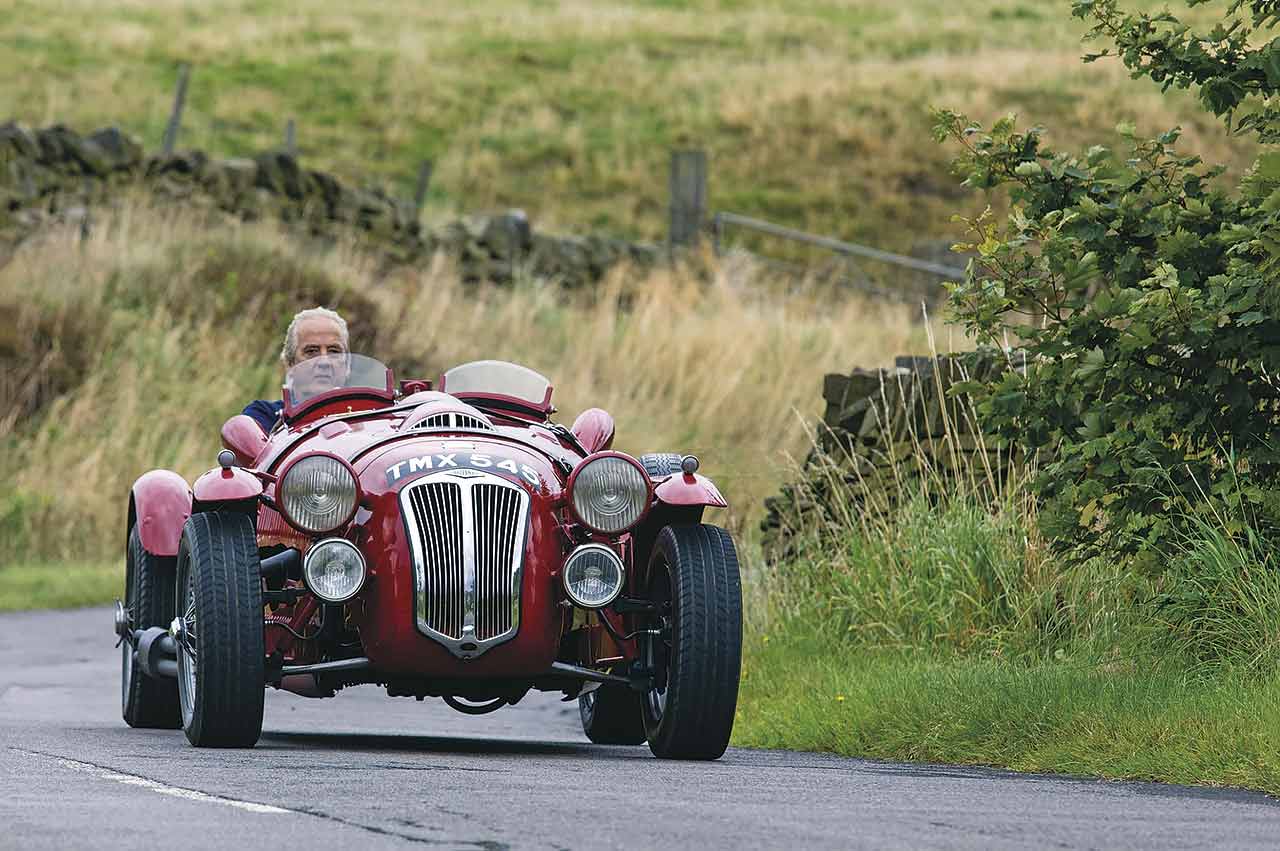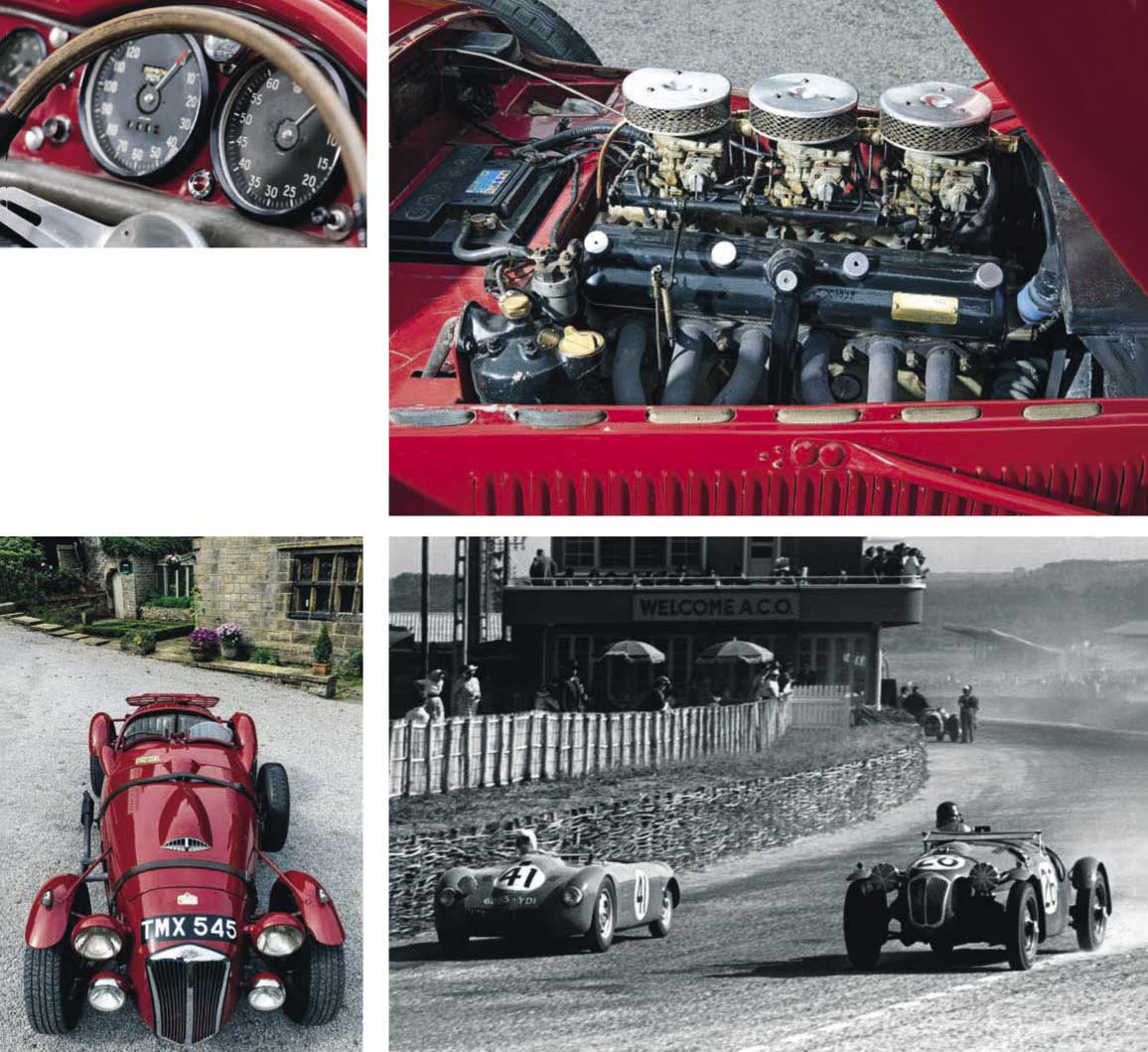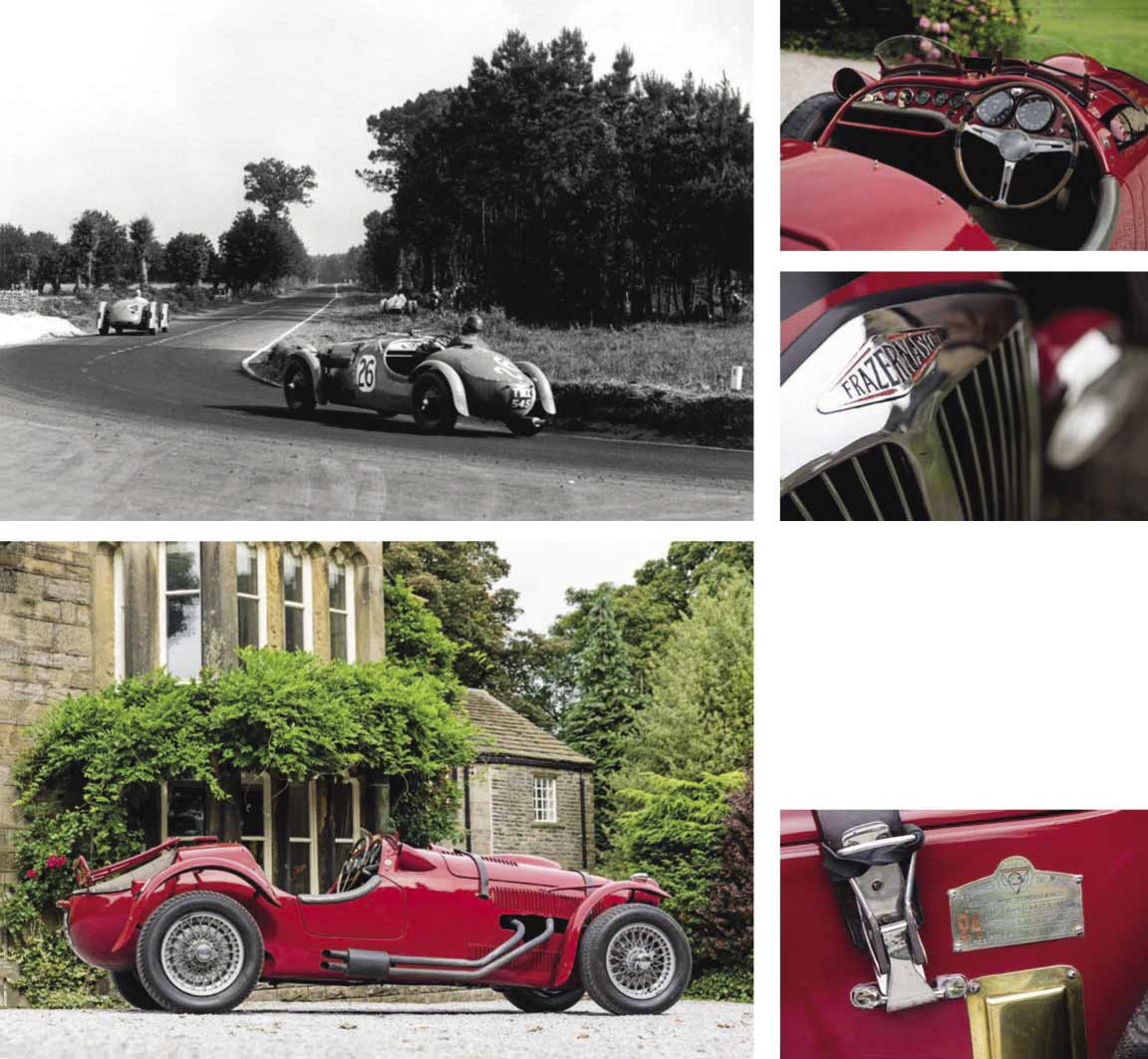
Frazer Nash High Speed Long-lost racer returns. We drive the ’1949 Frazer Nash that gave birth to the Le Mans Replica. The Nash that’s not a Rep. This High Speed racer inspired an icon and then refused to retire. All that ‘Replica’ business began here… Martin Buckley falls for the charms of a very special Frazer Nash as he tells the story of the High Speed that raced at La Sarthe in 1949 and ’1950, and inspired the iconic Le Mans Rep. Photography Phil Russell/LAT.
Any Frazer Nash is a very special car and the Le Mans Replicas are perhaps the most revered of all. It would be fair to say that they represent the pinnacle of the marque’s post-war reputation: fast, forgiving and rugged, they were the outstanding British sports car in the 2-litre class between 1948 and 1953. Capable of outright wins in events such as theTarga Florio, they were also eminently usable on the road.

Like so many truly great cars, they seem to have an influence out of all proportion to the scant number built. There were just 30 Le Mans Replicas (if you include, as you must, the eight Mk2s with de Dion rear suspension) and four High Speeds – the name initially given to these cycle-winged, BMW-inspired machines when they made their debut at the first post-war Earls Court show in 1948, priced at £3000.
Bought new by a Yorkshire mill owner called Norman Culpan, chassis 421/100/008 was the last of the High Speeds to be minted. Connoisseurs of the marque might know it better by its Middlesex county registration, TMX545.
It was in this very machine at Le Mans in 1949 that Culpan shared the driving with AFN boss HJ Aldington. Despite losing its clutch, TMX came third overall at this first post-war French 24-hour event, and was the highest-placed British entrant against impressive competition from Ferrari, Aston Martin and Delage.
Thus, it was this car that was the inspiration for all subsequent Le Mans Replicas to emerge from the Falcon Works in Isleworth through to 1953. It featured extensively in AFN advertising, made the front cover of Autosport and actually ran again at Le Mans in 1950, where it finished 20th overall and second in class.
That alone would make it important enough, but what is equally special about TMX is the second life that it went on to have. From the late ’50s through to the early ’70s it was campaigned in the hands of a Yorkshire farmer called Cecil Booth (‘Cec’ to those who knew him), a truly remarkable character and natural racer who was as grittily competitive as the car itself.

Born in 1920, Booth got a taste for speed on a Brough Superior before the war and had his first circuit race in a 10-year-old Healey Duncan at Aintree in 1958. Impressed by the pace of the Bristol-engined AC Aces, Cec soon realised that he needed something more competitive. By chance, a friend tipped him off about the Nash, which was still in the hands of first owner Culpan and mothballed in a garage half an hour from where he lived. It was only when Booth saw the car that he realised both its significance and that he had even seen it before, when he attended (as a spectator) the Dundrod TT in 1950.
Culpan was a successful pre-war motorcycle racer who competed in TMX 545 for three seasons, mostly in national events with honourable results, although the car appears to have been bedevilled by clutch problems. It seems that Culpan had been advertising the Nash quietly since 1956, but it still took Booth 18 months to persuade him to sell the car. Even then, he only just managed to scrape together the £600 asking price. The new owner later confessed that it was “one of my better investments”.
‘THE NASH WAS A FAMILIAR WAKEUP CALL IN THIS BLEAK, BEAUTIFUL PART OF THE WORLD’
After Booth’s death in 2000, the Nash passed to his daughters Anne and Lesley and his son John, who sadly later died in a motorcycle accident. Although it is well looked after and much loved, few outside the family get to see TMX these days apart from rare appearances at local shows. In truth, the car’s existence is not entirely hermit-like, and you might have spotted it at Hampton Court during the 2014 Concours of Elegance. Even so, I felt suitably privileged, on a bright afternoon in late August, to be in the presence of this prized heirloom and racing legend.
Anne, who drives her late father’s 911 as a daily runabout, can still clearly recall the rainy afternoon in February ’1959 when she first laid eyes on TMX: “I was 12 when my dad bought the car, and he was quite excited about it. I said to him, ‘Can you come and pick me up from school?’ It was something he never did, so I didn’t really expect him to come. Anyway, I was with all my friends and I heard this car coming up the road… they all said, ‘What’s this?’ It looked old-fashioned even in those days.” She got in and her father drove her proudly to the top of the road. “It started fluffing a bit,” she recalls, “but I desperately didn’t want him to stall in front of my friends.”

Already in his late 30s, Booth drove TMX in club races, hillclimbs and sprints up and down the country, dicing wheel-to-wheel with the latest machinery in a car that was already a good 10 or 15 years older than everything else on the circuit. Booth didn’t keep much in the way of records of his considerable achievements, but his 14 seasons of motorsport in the venerable Nash earned him 23 overall or class firsts, 23 second places and eight thirds – competing in grids that included the likes of Barrie Williams, Tony Lanfranchi, Mike Parkes and John Surtees.
“Some of the other drivers in the 2-litre class used to complain and say he shouldn’t be there,” recalls Anne, “but only because he was beating them! In any case, there was nowhere else for him to be.” For younger sister Lesley, TMX was simply a car that was important to her father – and which clearly brought him a lot of joy – but she was too small to really understand the significance.
Being older, Anne was able to appreciate the Nash more keenly: “I got my love of cars from Dad and I used to go with him to the races. I got quite miffed if anyone else went with him!”
Booth’s hobby took him and TMX as far south as Brands Hatch, but he could more often be found at windswept venues such as Catterick, Linton, Oulton Park, Cadwell, Castle Howard and the hillclimb at Harewood, where Lesley met her future husband after her father gave him permission to drive the Nash. It was at Silverstone, though, where Booth enjoyed perhaps his finest hour when he won his class and came third overall (behind a DB3S) at the Martini 100 meeting in ’1963. Running taller 16in rear wheels for the long straight, he fared well in this Aston Martin Owners Club event throughout the ’60s.
Flick through Autosport from the period and the Booth/TMX partnership can often be spotted in event reports. With the grille removed to prevent it from getting damaged (they were expensive, even then), this determined figure could be seen towering above the Lotus Elites and 2-litre ‘moderns’. Or mixing it with Lister- Jaguars as he leaned into a four-wheel drift, or flicking through the cones at a long-forgotten speed test – the Burton’s (as in the tailors) Sprint in Leeds was a favourite. What the report would not say is that the man behind the wheel had driven TMX to the event and would almost certainly drive it back. It is thought that the Nash was only ever trailered home from one event.
Booth could not have been further from the playboy racing driver image. Farming and pig rearing being as uncertain a profession in the ’50s and ’60s as it is today, Cec was not a wealthy man. That said, the beloved Nash always got what it needed. He was not shy, for instance, of sending the gearbox to Bristol at the end of every season for a pricey rebuild. Generally, however, TMX was maintained and developed on a tight budget, which makes the length of its competitive life in his hands all the more amazing.
Enthusiastically assisted by his young neighbour Neil Howarth, Booth would think nothing of working until 4am on a Saturday morning to replace a head gasket, or experimenting with different types of exhaust and then testing the results at dawn on the deserted Pennine roads near his Huddersfield farm. The open-throated blare of the Nash was a familiar wake-up call in this bleak, beautiful part of the world.
I asked Howarth if he got to pilot TMX much in those days: “He always used to ask me to drive it but I was bit nervous in case anything happened, although I don’t think he was too worried.”
Like any good racing war horse, it got bumped a few times in anger, recalls Howarth: “On Tuesday nights we used to go over to Aintree to experiment with the exhaust, and I remember we had an accident. Another time someone spun in front of him in a race and he had nowhere to go.”
To say that TMX 545 is ‘original’ is not to say it is quite the car that appeared at Le Mans in 1949. Having driven the Nash for its first season, in 1960 Booth started developing it in earnest in an attempt to keep it competitive. To put more power down in corners it got a de Dion rear axle from a crashed Mk2 quite early on. When said de Dion broke a hub in 1965, Cec got his older brother Roy, who – handily – ran an engineering firm, to fabricate him a new tube from scratch. Triumph TR3 front discs were fitted not necessarily for their superior stopping power, but because Booth got tired of forking out for expensive Alfin drums, which cracked regularly. Inexpensive, long-lasting Michelin X rubber was preferred wear for many years. The current 60-profile tyres were fitted when TMX did the Le Mans Classic and came at the best price of all for a true Yorkshireman: nowt.
In the early ’60s, meanwhile, Booth fitted Koni dampers all round and got Dunlop to make the 15in wires that the Nash wears to this day, although the original disc wheels (along with the bootlid) are stored with the car.
Not so the factory 115bhp Le Mans engine, FNS 1/3. In period, Booth was looking for power rather than worrying about matching numbers, so he replaced it in the early ’60s with a 100D2 version of the Bristol straight-six that would rev to a full 6000rpm and give 140bhp in its ultimate form. Later came an ex-Formula 2 Bristol unit that gobbled so much oil at racing speeds that a Heath-Robinson tube-and-funnel arrangement had to be attached to the passenger grabhandle so that Booth could feed it a pint of oil every five laps. Today the Nash is running the 100D2 (with lower-compression pistons) and it goes very well on about 120bhp.

Howarth warms it up carefully before we take to the road and, as I clamber in, gives friendly instructions about where to lean on the alloy body without leaving a dent. It’s a snug fit behind the wood-rim wheel, but would have been even snugger behind the original BMW 328 type.
Once you’re on the move, it doesn’t take long to understand why these machines are so revered. The high-geared steering is beautifully direct and fingertip precise, the rasping engine lusty and willing. Running its Le Mans 3.75:1 axle ratio, progress is uncertain below 3000rpm but gets stronger all the way up to an ear-splitting 5500rpm, with some blue exhaust puffs between gears. The brakes feel strong, the gearbox a satisfying precision instrument that is there to be used and enjoyed, if not exactly rushed.
It is a tiny car, yet has a huge sense of presence, urgency and occasion about it. The six-dial dash is what Culpan and Aldington would have seen in 1949, and the elegantly crumpled leather seats are the 69-year-old originals. Views through the aeroscreens along the shapely bonnet towards the bug-eyed Bosch headlamps and cycle wings are more evocative of the ’30s than the ’50s. But then that is what the Nash is all about: a ‘vintage’ sensibility in a forgiving post-war car. It flatters even the modestly ambitious with a seat-of-pants feel born of a very stiff tubular chassis and faithful rollfree handling that caters to every sporting whim.
At what point TMX’s original engine was sold is lost in the mists of time, but, as with so many cars in long-term ownership, custodians – bereft of a crystal ball – tend to do what feels right ‘in the moment’ rather than take a view on historical significance 40 years down the line. Booth seems to have been a practical man who looked forward not back. Neither Anne nor Lesley is sure what made him stop racing the Nash in his early 50s, but let us assume the car’s sheer antiquity (rather than his) was becoming impossible to ignore.
“SOME OF THE OTHER DRIVERS IN THE 2-LITRE CLASS USED TO SAY THAT THE NASH SHOULDN’T BE THERE, BUT ONLY BECAUSE IT WAS BEATING THEM”
In the ’70s and ’80s, with TMX in retirement but still used occasionally on the road, Booth’s interests turned to fast road cars: everyone smiles when they remember the delivery of his first Ferrari. Picture the scene of the Maranello salesmen meeting Booth in the car park of the local boozer and finding it difficult to believe that this rustic, pipe-smoking character in a flat cap and muddy wellies was really the owner of a Dino. He went on to buy a Boxer and 308GTB, plus a BMW 6 Series that is still in the family.
Booth’s interest in the Nash was renewed after he retired from farming. With invites to the most exotic events he was able to take fresh joy, late in life, in a car that was in many ways integral with his own character and history. That deep human connection today makes TMX one of the most fascinating examples of a rarefied breed, all of which, by their very nature, have an interesting tale to tell. It’s a car that not only exudes history from every pore, but must surely be the only two owner unrestored Frazer Nash in the world.
Who’d have thought that in 2018 this near- 70-year-old thoroughbred of such significance and provenance would still never have been across an auction block or seen the inside of a Kensington Mews showroom?






